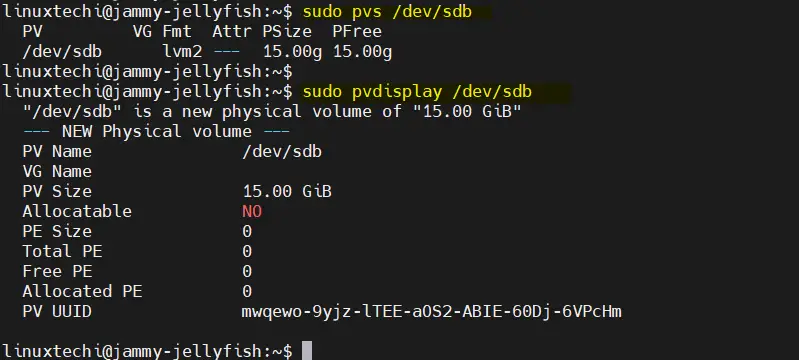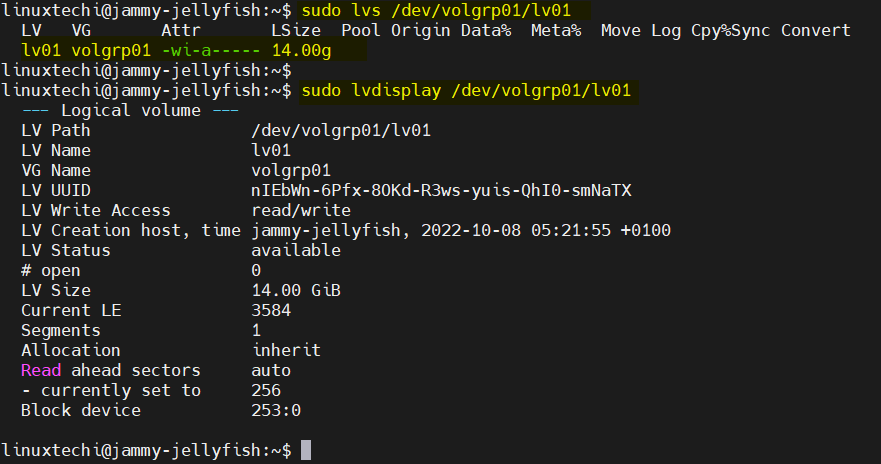How to Create LVM Partition Step-by-Step in Linux
In this guide, we will cover how to create lvm partition step-by-step in Linux.
LVM stands for Logical Volume Management, it is the recommended way to manage disk or storage on Linux systems specially for servers. One of the main advantages of LVM partition is that we can extend its size online without any downtime. LVM partition can also be reduced but it is not recommended.
For the demo purpose, I have attached 15GB disk to my Ubuntu 22.04 system, we will create LVM partition on this disk from the command line.
Prerequisites
- Raw disk attached to Linux system
- Local User with Sudo rights
- Pre-Installed lvm2 package
Without further ado, let’s deep dive into the steps.
Step 1) Identify new attached raw disk
Login to your system, open the terminal and run following dmesg command,
$ sudo dmesg | grep -i sd
In the output, look for new disk attached of size 15GB,

Alternate way to identify new attached raw disk is via fdisk command,
$ sudo fdisk -l | grep -i /dev/sd
Output,

From output above, it is confirmed that new attached disk is ‘/dev/sdb’
Step 2) Create PV (Physical Volume)
Before start creating pv on disk /dev/sdb, make sure lvm2 package is installed. In case it is not installed, then run following command,
$ sudo apt install lvm2 // On Ubuntu / Debian $ sudo dnf install lvm2 // on RHEL / CentOS
Run following pvcreate command to create pv on disk /dev/sdb,
$ sudo pvcreate /dev/sdb Physical volume "/dev/sdb" successfully created. $
To verify pv status run,
$ sudo pvs /dev/sdb Or $ sudo pvdisplay /dev/sdb

Step 3) Create VG (Volume Group)
To create a volume group, we will use vgcreate command. Creating VG means adding pv to the volume group.
Syntax :
$ sudo vgcreare <vg_name> <pv>
In our case, command would be,
$ sudo vgcreate volgrp01 /dev/sdb Volume group "volgrp01" successfully created $
Run following commands to verify the status of vg (volgrp01)
$ sudo vgs volgrp01 Or $ sudo vgdisplay volgrp01
Output of above commands,

Above output confirms that volume group (volgrp01) of size 15 GiB is created successful and size of one physical extend (PE) is 4 MB. PE size can be changed while creating vg.
Step 4) Create LV (Logical Volume)
Lvcreate command is used to create LV from the VG. Syntax of lvcreate command would look like below,
$ sudo lvcreate -L <Size-of-LV> -n <LV-Name> <VG-Name>
In our case, following command will be used to create lv of size 14 GB
$ sudo lvcreate -L 14G -n lv01 volgrp01 Logical volume "lv01" created. $
Validate the status of lv, run
$ sudo lvs /dev/volgrp01/lv01 or $ sudo lvdisplay /dev/volgrp01/lv01
Output,

Output above shows that LV (lv01) has been created successfully of size 14 GiB.
Step 5) Format LVM Partition
Use mkfs command to format the lvm partition. In our case lvm partition is /dev/volgrp01/lv01
Note: We can format the partition either ext4 or xfs, so choose the file system type according to your setup and requirement.
Run following command to format LVM partition as ext4 file system.
$ sudo mkfs.ext4 /dev/volgrp01/lv01

Execute beneath command to format the lvm partition with xfs file system,
$ sudo mkfs.xfs /dev/volgrp01/lv01
To use above formatted partition, we must mount it on some folder. So, let’s create a folder /mnt/data
$ sudo mkdir /mnt/data
Now run mount command to mount it on /mnt/data folder,
$ sudo mount /dev/volgrp01/lv01 /mnt/data/ $ df -Th /mnt/data/ Filesystem Type Size Used Avail Use% Mounted on /dev/mapper/volgrp01-lv01 ext4 14G 24K 13G 1% /mnt/data $
Try to create some dummy file, run following commands,
$ cd /mnt/data/ $ echo "testing lvm partition" | sudo tee dummy.txt $ cat dummy.txt testing lvm partition $ $ sudo rm -f dummy.txt
Perfect, above commands output confirm that we can access lvm partition.
To mount above lvm partition permanently, add its entries in fstab file using following echo command,
$ echo '/dev/volgrp01/lv01 /mnt/data ext4 defaults 0 0' | sudo tee -a /etc/fstab $ sudo mount -a
That’s all from this guide, thanks for the reading. Kindly do post your queries and feedback in below comments section.
Read Also: How to Extend XFS Root Partition without LVM in Linux
The post How to Create LVM Partition Step-by-Step in Linux first appeared on .
